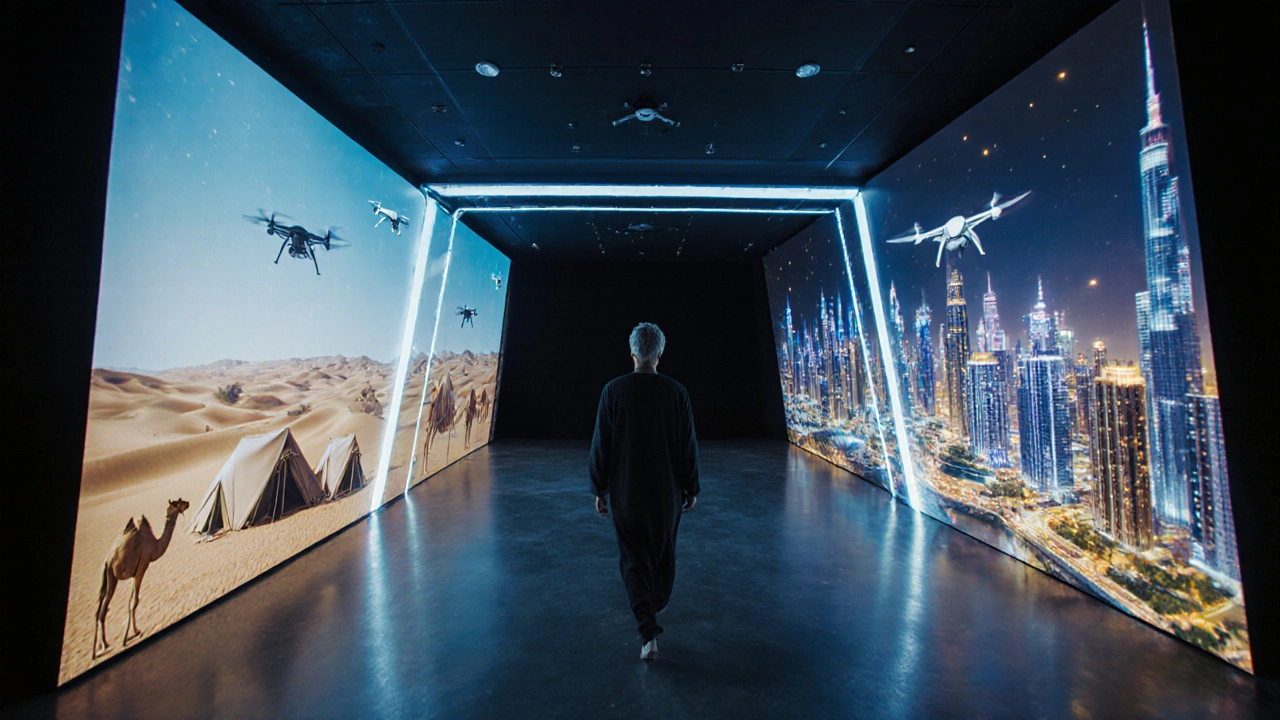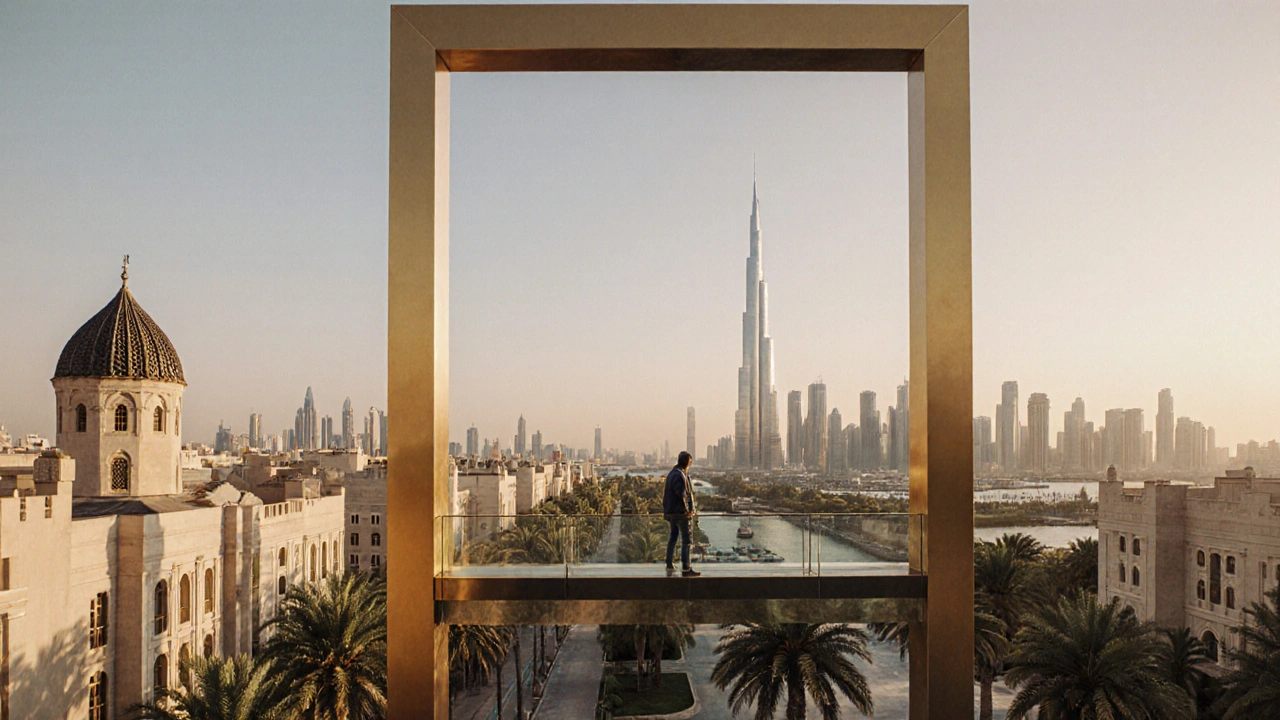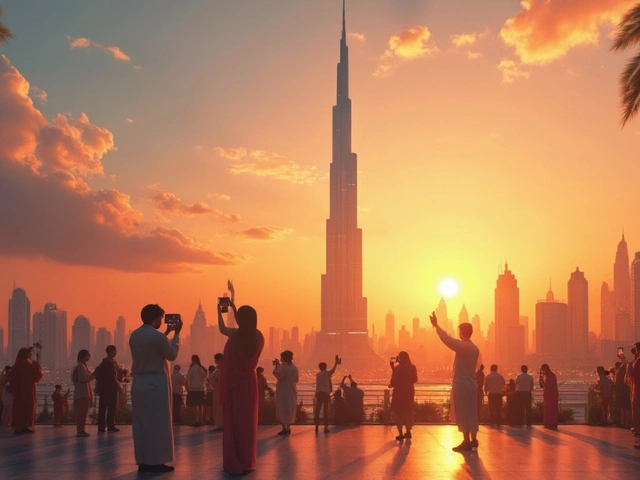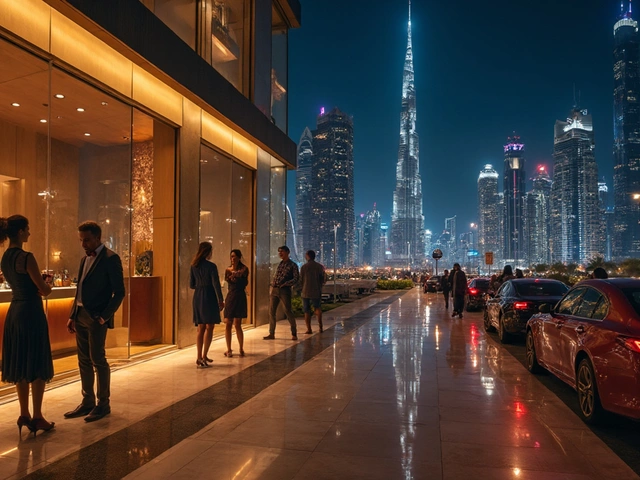You’ve seen the photos-the giant golden frame standing tall between old Dubai and new Dubai, like a picture window into the city’s soul. But what’s really behind that frame? It’s not just a photo op. It’s a story. A story of sand dunes turning into skyscrapers, of traders becoming tycoons, of traditions holding ground amid glass and steel. The Dubai Frame isn’t just architecture. It’s a bridge.
What Is the Dubai Frame?
The Dubai Frame is a 150-meter-tall vertical structure shaped like a giant picture frame. It sits in Zabeel Park, connecting the historic district of Al Fahidi with the modern skyline of Dubai Marina. Built in 2018, it was designed to show how Dubai transformed from a quiet coastal settlement into one of the world’s most ambitious cities. Inside, you’ll find a museum on the ground floor, glass-floored skywalks, and panoramic views that stretch from the old souks to the Burj Khalifa.
Think of it as a living timeline. On one side of the frame, you see the low-rise buildings, wind towers, and narrow alleyways of old Dubai. On the other, the glittering towers of Downtown and Business Bay. The frame doesn’t just show you the change-it makes you feel it.
Why Does the Dubai Frame Matter?
Most cities have monuments to their past or their future. Dubai has both-and the Frame puts them side by side. You don’t need a history book to understand how fast this place changed. Just stand on the skywalk, look left, then right. One side has families sitting under palm trees, selling dates and cardamom coffee. The other has people in suits sipping espresso on rooftop terraces, watching drones fly past the Burj Al Arab.
This isn’t just about architecture. It’s about identity. Dubai didn’t erase its roots to build its future. It carried them forward. The Frame reminds visitors-and locals-that progress doesn’t mean forgetting. It means evolving.
What Can You Experience Inside?
The Dubai Frame isn’t just a view. It’s an immersive journey.
- The Ground Floor Museum: Walk through interactive displays that show Dubai’s evolution-from pearl diving in the 1950s to hosting Expo 2020. You’ll see vintage photos, audio stories from Emirati elders, and even a recreated traditional dhow boat.
- The Sky Deck: Step onto the glass floor 150 meters up. Below you, the city splits in two. The sound of the city fades. All you hear is your own breath. It’s eerie. Beautiful. Real.
- The View from the Top: On a clear day, you can see the Hatta Mountains in the distance, the Palm Jumeirah to the east, and the Dubai Creek to the west. No camera lens does it justice. You have to be there.
There’s also a 360-degree digital projection tunnel that simulates a flight over Dubai’s history. You’ll fly over Bedouin camps, then suddenly, you’re soaring above the Burj Khalifa at night. It’s not just a show-it’s a time machine.
How Is the Dubai Frame Different From Other Landmarks?
Unlike the Burj Khalifa, which is about height, or the Palm Jumeirah, which is about scale, the Dubai Frame is about contrast. It doesn’t compete with other landmarks-it connects them. It doesn’t scream for attention. It invites you to pause.
Other cities have museums. Dubai has a frame. And inside that frame, you’re not just looking at history-you’re standing between two worlds.

Who Should Visit the Dubai Frame?
If you’re here for the luxury hotels and shopping malls, you might skip it. But if you want to understand why Dubai feels so different from other global cities, this is where you start.
- First-time visitors: Do this early in your trip. It gives context to everything else you’ll see.
- Long-term residents: You’ve lived here for years? You still might not have seen the full picture. The Frame shows you what you’ve been walking past.
- Families: Kids love the glass floor. Parents love the quiet moments away from crowds.
- Culture lovers: The museum tells stories you won’t find on Instagram. Real voices. Real struggles. Real pride.
How to Get There and When to Go
The Dubai Frame is in Zabeel Park, just a 10-minute drive from Dubai Mall. You can take the metro to Al Jafiliya station and walk 15 minutes, or hop in a taxi-most drivers know it well.
Best time to go? Late afternoon. Arrive around 4 PM. Walk through the museum as the sun starts to dip. Then head up to the skywalk just as the lights turn on. You’ll see the old city glow gold, and the new city sparkle blue. It’s a moment you’ll remember longer than any selfie.
Weekends get busy. If you can, go on a weekday. You’ll have the glass floor to yourself.
What to Expect When You Pay to Enter
Tickets cost AED 50 for adults, AED 20 for children under 12, and free for seniors over 60 and people with disabilities. Online booking is recommended-you can do it on the official Dubai Frame website or through Klook. Skip the line, save time, and get a digital audio guide included.
Inside, there’s no extra cost for the museum or the skywalk. No hidden fees. No upsells. Just pure experience.

Dubai Frame vs. Other Cultural Landmarks in Dubai
| Feature | Dubai Frame | Al Fahidi Historical Neighbourhood | Dubai Museum (Al Fahidi Fort) | Heritage Village |
|---|---|---|---|---|
| Focus | Contrast between old and new Dubai | Preserved traditional architecture | Historical artifacts and exhibits | Live cultural demonstrations |
| Height/View | 150m panoramic skywalk | Ground level only | Ground level only | Ground level only |
| Interactive Tech | Yes-digital projections, touchscreens | No | Minimal | No |
| Best for | Understanding Dubai’s transformation | Photography, quiet walks | History buffs | Families wanting hands-on culture |
| Time needed | 1.5-2 hours | 1 hour | 45 minutes | 1 hour |
Frequently Asked Questions
Is the Dubai Frame worth visiting?
Yes-if you want to understand Dubai beyond the glitz. It’s not a thrill ride. It’s a quiet, powerful reminder of how the city grew. You’ll leave with more than photos. You’ll leave with perspective.
Can you take photos inside the Dubai Frame?
Absolutely. In fact, it’s designed for it. The glass floor and the framed views make for perfect shots. But don’t just snap a selfie. Look around. The real photo is the contrast between old and new-your view, not your face.
Is the Dubai Frame wheelchair accessible?
Yes. The entire complex has elevators, ramps, and accessible restrooms. The glass skywalk is fully accessible, and audio guides are available in multiple languages.
How long does a visit take?
Most people spend 1.5 to 2 hours. If you’re rushing, you can do it in 45 minutes. But if you want to soak it in-read the stories, watch the projections, sit quietly on the skywalk-give yourself more time.
Is the Dubai Frame open every day?
Yes. It’s open daily from 9 AM to 9 PM. Last entry is at 8 PM. It’s open on public holidays too, including Eid and National Day.
Are there food options nearby?
Yes. Zabeel Park has several cafés and kiosks selling Emirati snacks like luqaimat (sweet dumplings), Arabic coffee, and fresh juices. You can also bring your own water and snacks-there are picnic areas outside.
Final Thought: It’s Not Just a Frame-It’s a Mirror
The Dubai Frame doesn’t show you what Dubai looks like. It shows you what Dubai became. And what it chose to keep.
When you stand on that glass floor, you’re not just looking at buildings. You’re looking at choices. Choices made by generations who held onto their heritage while reaching for the sky. That’s rare. That’s powerful. That’s Dubai.
So next time you’re here, don’t just take a photo. Take a moment. Look left. Look right. Then ask yourself: What will your city look like in 50 years? And what will you hold onto?







siva kumar
November 16, 2025 AT 19:07The Dubai Frame isn’t just architecture-it’s a damn philosophy. I stood on that glass floor at sunset and felt like I was suspended between two centuries. Old Dubai smells like cardamom and sweat, new Dubai smells like espresso and AC. And somehow, they’re not fighting-they’re dancing. The museum? Real stories from elders who watched their dhow become a cruise ship. No filter. No PR spin. Just truth. I’m Indian, grew up in a city that bulldozed its past for malls, and I cried. Not because it’s pretty-because it’s honest.
satish gottikere shivaraju
November 18, 2025 AT 02:44This made my day 😊 I visited last month and honestly? I thought it’d be just another tourist trap. But that 360 projection? I swear I felt the wind from the desert blow through me. And the glass floor? My kids screamed and then whispered, ‘Dad… is this magic?’ 💫
Abraham Pisico
November 18, 2025 AT 18:39Oh, so now architecture is a ‘mirror’? How poetic. Let me grab my journal and a cup of chamomile tea while I contemplate the existential weight of a 150-meter frame. Honestly, I’m shocked Dubai didn’t just build a giant Instagram filter and call it ‘Cultural Enlightenment.’ But hey-kudos for not turning it into a McDonald’s with a view. Still, calling it a ‘bridge’? Nah. It’s a billboard. A very expensive, very shiny billboard that says: ‘Look how far we’ve come… and also, please buy tickets.’
Tarapada Jana
November 18, 2025 AT 20:21Let’s be real: this is performative heritage. The ‘old Dubai’ side is a sanitized, curated museum piece-like a diorama in a theme park. Real Al Fahidi is crumbling, ignored, and underfunded. Meanwhile, the Frame gets a billion-dollar budget and a drone show. It’s not a bridge-it’s a prop. A symbol of capitalism’s ability to commodify nostalgia. And don’t get me started on the ‘authentic’ audio stories. They’re narrated by actors paid by the Dubai Tourism Board. It’s not history. It’s branding with a side of emotional manipulation.
Lippard Babette
November 19, 2025 AT 09:53Just wanted to say thank you for this post-it made me want to book a flight tomorrow! 😊 I’ve been to Dubai twice but skipped the Frame both times because I thought it was just for tourists. But reading this? I felt like I missed the soul of the place. I’m going back next month and I’m bringing my mom. She’s 72, loves history, and hasn’t stopped talking about how much she wants to see the glass floor. You’ve reminded me that sometimes the quietest places hold the loudest stories.
Srimon Meka
November 21, 2025 AT 09:40You think that’s deep? Try standing on that skywalk at 5 AM when the call to prayer echoes from the old quarter and the Burj Khalifa lights up behind you. That’s not a frame-that’s a spiritual experience. People who call it ‘performative’ haven’t lived through the real Dubai-the one where your uncle sold fish in Deira and now owns three hotels. This isn’t a gimmick. It’s a monument to grit. And if you’re too cynical to feel it, maybe you’re the one who needs to change-not the city.
Cheryl Ying
November 21, 2025 AT 13:55Wow. Another ‘poetic’ take on a tourist attraction. I went. Saw the glass floor. Kids screamed. I rolled my eyes. It’s expensive, crowded, and the ‘museum’ is basically a PowerPoint slideshow with sound effects. And the ‘real voices’? Recorded in a studio. No wind. No sweat. No truth. Just a 50-AED experience designed to make rich tourists feel like they’ve ‘understood’ a culture they’ll never live. Save your money. Go to the souk. Talk to a vendor. That’s real.
William Driscoll
November 22, 2025 AT 06:18Correction: The Dubai Frame is not 150 meters tall-it’s 149.7 meters. The official website states it as ‘approximately 150m,’ which is misleading. Also, the museum’s audio guide claims ‘traditional dhow boats’ were used for pearl diving in the 1950s. Factually incorrect: the last commercial pearl diving in the UAE ended in the early 1940s. Furthermore, the term ‘Emirati elders’ is vague and non-specific. Who? When? Where? No citations. No sources. This post reads like a PR brochure masquerading as journalism. And ‘you have to be there’? No. You don’t. You just have to be gullible.